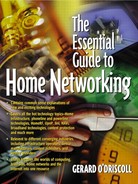SUMMARY
At present we are in a global socioeconomic transition period, changing from an industrial-based analog economy to an information-based digital economy. The impetus for this transition has been fueled by four converging trends:
The global deregulation of the communications and utility industries.
The decreasing costs and increasing power of silicon intelligence (microchip processors).
New communications technology, like broadband local loop connectivity and in-home networks, that will bring high-speed Internet access to residential consumers.
The adoption of the Internet as a commercial channel.
The growth of the emerging economy will be driven primarily by a new breed of digitized products and services, including:
Virtual products, called digital media commodities (DMCs), which consist of digital content in a variety of different formats, including communications, information, and entertainment titles.
Service-based activities that are built on the development, distribution, and transmission of the DMCs to consumers.
More than just a connection to the Internet, the home infostructure serves as the technology platform that will enable an entirely new generation of user applications, including voice and video communications, e-commerce, personalized news, home security and automation, utilities resource management, and entertainment title distribution. The home infostructure holds significant economic importance to businesses because it serves as a hyperefficient, mass-market distribution platform that can deliver digital media content and value-added services directly into the hands of the consumer.
Home infostructure will be enabled by three distinct technologies: broadband local loop connectivity, residential gateways, and in-home networks. The technology components that constitute the home infostructure are being developed by many different companies and deployed by disparate industries. These include the long distance telcos, ISPs, electric utilities, satellite operators, and cable operators, in addition to many new start-ups and international technology consortiums.
While the information economy derivative market model is not a definitive answer for predicting what will suddenly appear on the day that the marketplace finally matures, it presents a solid framework for evaluating business models and technological trends. This model offers a very broad and comprehensive view of the market so individual entrepreneurs can sharpen their business focus and understand the value of establishing strategic partnerships.
The consumer marketplace, and the society of people that lies behind it, is more organic and unpredictable than can be pinned down through theoretical models or scientific calculations. But by identifying the underlying forces of the market system and understanding the nature of its chaotic tendencies, decision makers and business leaders will be better equipped to deal with the evolving competitive challenges that their organizations will face.
